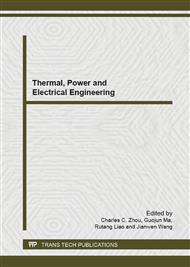p.204
p.209
p.213
p.218
p.224
p.230
p.234
p.238
p.242
Distribution Characteristics of Exergy Dissipation of a Large-Scale Coal-Fired Power Generation Units
Abstract:
The distributions of exergy dissipation in a 1000MW coal-fired power plant under different operation conditions were analyzed. Mass and energy balance models of different components were constructed to determine the thermodynamic properties of each stream. A variant of exergy analysis, the proposed equivalent specific fuel consumption (ESFC) analysis, were conducted to determine the additional specific fuel consumptions (ASFC) of individual component and, therefore, to obtain the characteristic of its temporal and spatial distribution. The off-design modeling of main components was established. The methodology and results of analysis in this paper can be taken as valuable guidance for the optimal design and operation of thermal power plants and for the improvement and retrofits for more cost-effective and environmental-friendly power plants.
Info:
Periodical:
Pages:
224-229
Citation:
Online since:
August 2013
Authors:
Price:
Сopyright:
© 2013 Trans Tech Publications Ltd. All Rights Reserved
Share:
Citation:


